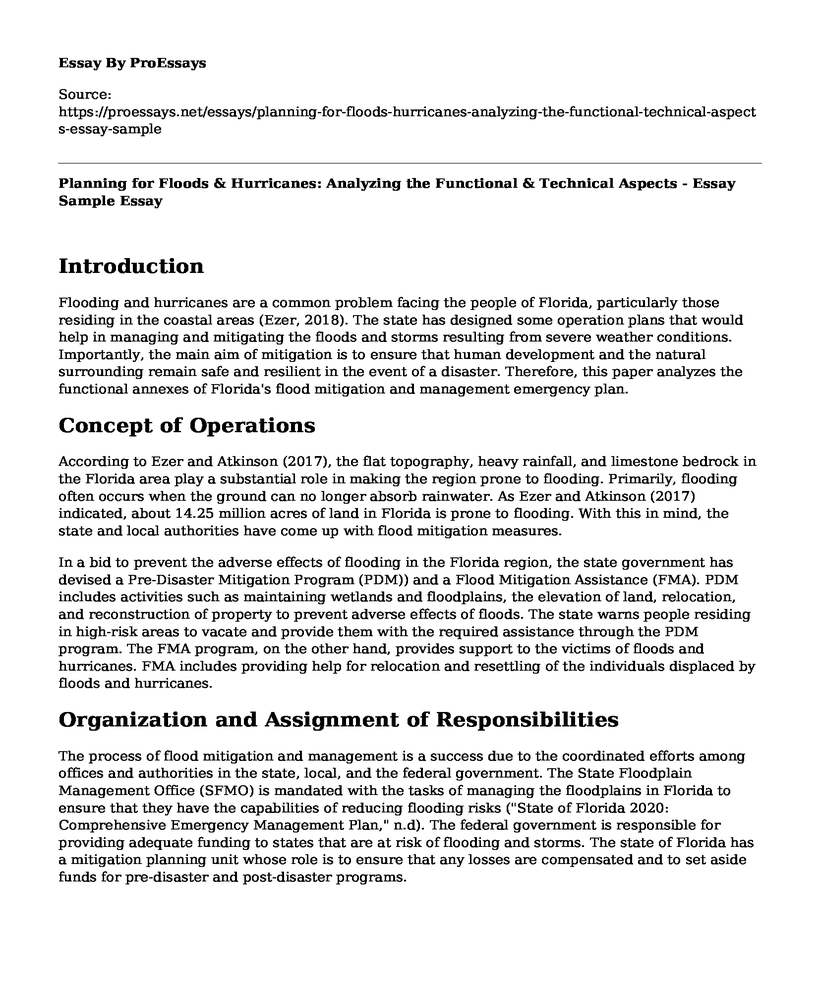Introduction
Flooding and hurricanes are a common problem facing the people of Florida, particularly those residing in the coastal areas (Ezer, 2018). The state has designed some operation plans that would help in managing and mitigating the floods and storms resulting from severe weather conditions. Importantly, the main aim of mitigation is to ensure that human development and the natural surrounding remain safe and resilient in the event of a disaster. Therefore, this paper analyzes the functional annexes of Florida's flood mitigation and management emergency plan.
Concept of Operations
According to Ezer and Atkinson (2017), the flat topography, heavy rainfall, and limestone bedrock in the Florida area play a substantial role in making the region prone to flooding. Primarily, flooding often occurs when the ground can no longer absorb rainwater. As Ezer and Atkinson (2017) indicated, about 14.25 million acres of land in Florida is prone to flooding. With this in mind, the state and local authorities have come up with flood mitigation measures.
In a bid to prevent the adverse effects of flooding in the Florida region, the state government has devised a Pre-Disaster Mitigation Program (PDM)) and a Flood Mitigation Assistance (FMA). PDM includes activities such as maintaining wetlands and floodplains, the elevation of land, relocation, and reconstruction of property to prevent adverse effects of floods. The state warns people residing in high-risk areas to vacate and provide them with the required assistance through the PDM program. The FMA program, on the other hand, provides support to the victims of floods and hurricanes. FMA includes providing help for relocation and resettling of the individuals displaced by floods and hurricanes.
Organization and Assignment of Responsibilities
The process of flood mitigation and management is a success due to the coordinated efforts among offices and authorities in the state, local, and the federal government. The State Floodplain Management Office (SFMO) is mandated with the tasks of managing the floodplains in Florida to ensure that they have the capabilities of reducing flooding risks ("State of Florida 2020: Comprehensive Emergency Management Plan," n.d). The federal government is responsible for providing adequate funding to states that are at risk of flooding and storms. The state of Florida has a mitigation planning unit whose role is to ensure that any losses are compensated and to set aside funds for pre-disaster and post-disaster programs.
Communications
Florida has a State Watch Office (SWO), which is a 24-hour state emergency and situational awareness communication center. The division is in charge of communicating and warning the federal and state governments and its constituents of the impending disasters. With these communications techniques in place, Florida has managed to warn people early enough before any hurricane or flooding incidents.
Funding for the Operations
Both the state and federal governments fund the flood mitigation and management program. Importantly, the state of Florida has a Federal Emergency Management Agency (FEMA) that warrants it for federal funding. Asides from that, the state works with different local and regional agencies to fund its critical programs such as Pre-Disaster Management Program (PDM) and Flood Mitigation Assistance (FMA).
Conclusion
From the analysis of functional annexes of the state of Florida emergency management plan, one can conclude that the state is disaster prepared. The coordinated approaches between the state, local, and regional agencies have made a flood-prone area reduce the risks associated with floods and hurricanes. Some of the discussed techniques include the fact that the state has a division that communicates to the authorities on any impending emergency. More so, Florida has funds for use in the event of flooding and hurricanes.
References
Ezer, T., & Atkinson, L. (2017). On the predictability of high water level along the US East Coast: can the Florida Current measurement be an indicator for flooding caused by remote forcing? Ocean Dynamics, 67(6), 751-766. doi: 10.1007/s10236-017-1057-0
Ezer, T. (2018). On the interaction between a hurricane, the Gulf Stream and coastal sea level. Ocean Dynamics, 68(10), 1259-1272. https://doi.org/10.1007/s10236-018-1193-1
State of Florida 2020: Comprehensive Emergency Management Plan. (n.d). Retrieved from https://www.floridadisaster.org/globalassets/cemp/2020-cemp/preliminary-draft-2020-state-cemp.pdf
Cite this page
Planning for Floods & Hurricanes: Analyzing the Functional & Technical Aspects - Essay Sample. (2023, Mar 09). Retrieved from https://proessays.net/essays/planning-for-floods-hurricanes-analyzing-the-functional-technical-aspects-essay-sample
If you are the original author of this essay and no longer wish to have it published on the ProEssays website, please click below to request its removal:
- Climate Change: An Annotated Bibliography Example
- Essay Sample on Marriott Courtyard
- Essay Example on Overweight & Weight Loss: A Challenging Issue
- Essay Sample on Health Records of Children: Parental Responsibility & Electronic Confirmation
- Making the World Smoke-Free: Governments Taking Action - Essay Sample
- Cultural Diversity: Impact on Social Worker-Client Communication - Intentionality is Key - Essay Sample
- Sexual Health - Report Example







